
Changing Times
I don’t suppose when American singer-songwriter Bob Dylan wrote and released his 1964 protest song “The Times They Are a-Changin’, he was particularly thinking about fruit. Nonetheless, like just about everything else on our planet, it has proved to be the case for the produce.
Growing up in the UK in the 1960s, with the exception of the likes of apples, pears and plums, fresh fruit was more or less considered a luxury for many of us. We were only ever guaranteed to sample the now humble orange at Easter and perhaps Christmas. The exotic banana was also still very much regarded as a special treat. The only time we were likely to taste the likes of peach, pineapple, grapes and cherries was when “our mams” opened a tin of fruit cocktail on the odd special Sunday.
Well, all aspects of life in the UK, as almost everywhere, have changed just a little bit since those halcyon days of the 1960s. This includes the great variety of exotic fruits that are now available to us from across the globe. Mangoes, pineapples, avocados, guavas, papayas, grapefruit, melons, kiwifruit, persimmons and lychees, are to name but a few varieties of exotic fruits being imported into the UK in ever growing quantities. While we once may never have heard of many of these tropical fruits, they are becoming increasingly familiar. Contrarily, here’s a brief narrative on five exotic fruits you may still not know:
Snake Fruit
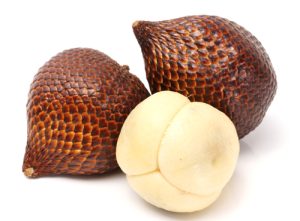
Photo credit: zcw/Shutterstock.com
Snake Fruit, also known as Salak, is an exotic fruit that originates from Indonesia. However, these days it can now be found throughout much of Southeast Asia. It has a reddish-brown, scaly skin that resembles that of a snake, which obviously gives rise to the fruit’s anglicised name.
The flesh of the snake fruit is creamy white and has a similar texture to that of an apple. Its sweet, tangy flavour is somewhere between that of a pineapple and banana. The fruit is mostly eaten fresh, though it can also be used in desserts, jams, and preserves. The fruit is also high in fibre, potassium, vitamin C and vitamin A.
Pepino
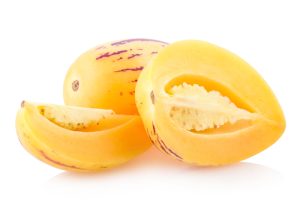
Photo credit: Viktar Malyshchyts/Shutterstock.com
The pepino, also known as the pepino melon, the tree melon, the melon pear and the pear melon, is native to South America. However, the fruit is now grown throughout many of the warmer climes of Europe. The fruit is a member of the nightshade family and therefore a relative of the tomato.
As some of its alternative names strongly suggest, the pepino has a taste that is somewhere between a pear and a melon. The fruit’s soft, sweet, tasty flesh is coloured golden yellow to yellow-orange and can be eaten raw and with the skin on. They can also be used as an ingredient in chutneys and preserves. The fruit as average levels of vital B-complex vitamins and minerals such as phosphorus, iron, calcium and manganese.
Sapodilla
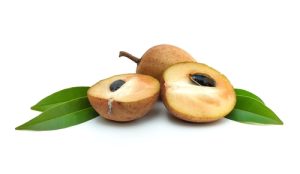
Photo credit: WeerajitJames/Shutterstock.com
The sapodilla’s other common name is the chicozapote, but amongst others, it is also known as the sapot, chicoo, chicle, naseberry or the nispero. It’s native to southern Mexico, Central America, and parts of the Caribbean. Introduced to the Philippines during the 16th-century Spanish colonization, it is now also widely grown through South East Asia.
The sweet tasting sapodilla’s yellowish brown flesh has been compared to that of a combination of pear and brown sugar. The sapodilla, when ripe, can be eaten raw but can also be made into the likes of jams, cake batters, chutneys, and custards. The nutritious fruit is not only high in fibre and but provides a good variety of vitamins and minerals. The sapodilla is particularly high in vitamin C and copper.
Kiwano
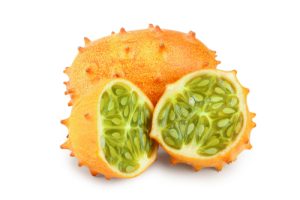
Photo credit: Nataly Studio/Shutterstock.com
The kiwano is also widely known as the horned melon, but its other names include the jelly melon, African horned cucumber, hedged gourd and melano. The fruit originates from the savannah regions of Southern Africa but is now also cultivated in the Antipodes, parts of Europe, Israel and Chile.
Both the seeds and the flesh of the kiwano can be eaten, though taste is dependant on its degree of ripeness. The green fruit tastes like cucumber but as it ripens the flesh becomes sweeter. A ripe kiwano is a yellowy orange colour and tastes like a cross between melon, banana and lime. The nutritious fruit is high in magnesium, potassium, iron, and antioxidants.
Mangosteen
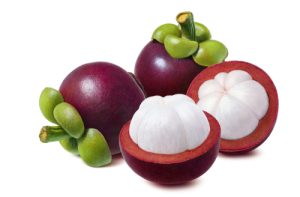
Photo credit: Kovaleva_Ka/Shutterstock.com
The mangosteen, sometimes known as “the queen of fruits”, originates from the countries that rim the Indian Ocean. It became established in parts of the Americas, namely Guatemala, Honduras, Panama, Ecuador, and the West Indies, during the 19th century.
The mangosteen has a thick purple inedible rind and a unique tasting, sweet and sour, delicate white flesh. It also has black seeds about the size of an almond which are edible though sometimes bitter, if mature. The fruit is mostly eaten fresh, individually or in fruit salads, but is also available canned or frozen. Low in calories and high in fibre, the fruit also provides a good range of essential vitamins and minerals. Additionally, mangosteens are also particularly well-known for their high antioxidant and anti-inflammatory content in the form of xanthones.
Header photo image: Cast of Thousands/Shutterstock.com





